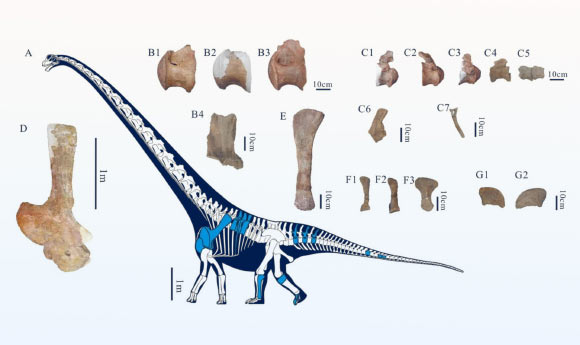Paleontologists in China have discovered the skeletal remains of a remarkable new genus and species of huge-sized mamenchisaurid dinosaur from the Late Jurassic epoch.
The newly-described species lived in what is now southwestern China some 147 million years ago (Late Jurassic epoch).
Scientifically named Tongnanlong zhimingi, this sauropod dinosaur was about 23 to 28 m (75.5-92 feet) long.
“Sauropods were gigantic, quadrupedal herbivores and the largest terrestrial dinosaurs ever existed,” said Dr. Xuefang Wei from the Chengdu Center of China Geological Survey and colleagues.
“They appeared in the Late Triassic, achieved a global distribution by the Middle Jurassic, and finally died out at the end of the Late Cretaceous.”
“More than 150 genera have been identified, including over 20 genera from the Jurassic period in China.”
“The southwestern China is a key region that yields Middle-Late Jurassic sauropod dinosaurs, particularly the Sichuan Basin,” they added.
“The sauropod fauna from the Middle-Late Jurassic Sichuan Basin has previously been considered an endemic fauna which differs from the contemporaneous sauropod faunae from the Pangean terrestrial faunae.”
“This distribution has often been interpreted by the East Asian Isolation hypothesis, which occurred during the Jurassic to Early Cretaceous.”
“However, this hypothesis is challenged by more phylogenetic analyses and studies of neosauropod dinosaurs from China and mamenchisaurid dinosaurs discovered from Africa which support the idea that they were distributed globally during the Middle Jurassic.”
The holotype specimen of Tongnanlong zhimingi was excavated from a building site in the Tongnan district of Chongqing area, the Sichuan Basin.
It includes three dorsal and six caudal vertebrae, scapula, coracoid, and some hindlimb bones.
“Our field work shows that the fossiliferous site belongs to the lower portion of the Upper Jurassic Suining Formation, overlying by the Quaternary deposits,” the paleontologists said.
“The Suining Formation consists of purplish red mudstone and sandstone.”
“Abundant invertebrate fossils are known from this formation, especially ostracods and stoneworts, along with some freshwater bivalves, conchostracans.”
“A few vertebrates are also known from this formation, such as fish Ceratodus szechuanensis, turtle Plesiochelys tatsuensis, and dinosaur Mamenchisaurus anyuensis.”
The team’s anatomical and phylogenetic analyses demonstrated that Tongnanlong zhimingi belonged to a family of sauropod dinosaurs called Mamenchisauridae.
“Mamenchisauridae was distributed globally in the Late Jurassic rather than an endemic fauna which was previously considered limited to East Asia,” the researchers concluded.
“Tongnanlong zhimingi enriches the diversity of eusauropods and provides new information on the understanding of the sauropod diversity and evolutionary trend from the Middle Jurassic to the Late Jurassic when their bodies became larger.”
Their paper was published July 10 in the journal Scientific Reports.
_____
X. Wei et al. 2025. A new mamenchisaurid from the Upper Jurassic Suining Formation of the Sichuan Basin in China and its implication on sauropod gigantism. Sci Rep 15, 24808; doi: 10.1038/s41598-025-09796-0


